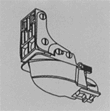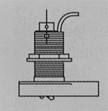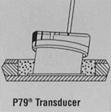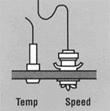 |
Guide to Marine
Transducers
Scuba Steve's Marine offers an wide range of matched, high performance,
high speed transducers for its various depth sounders. There are transducers
for virtually every type and size of boat -- sail boats, large power boats, "trailerables" and
more. There are also separate sensors you can install that will read
your boat speed and the surface water temperature.
We can recommend the best type of transducer for your boat; we will make sure
it matches your sounder; and he can help you install both your transducer and
your sounder. For do-it-yourselfers, installation instructions are available
for all our transducers. To help make your transducer selection easier, we
have provided a general guide to the basic types of transducers along with
a brief description of where and how to install each.
TRANSOM
MOUNT TRANSDUCERS As the name indicates, this style
of transducer mounts on the transom. The best mounting  location is
at the bottom of the transom with the face (bottom) of the transducer
on a nearly horizontal plane, as shown in these two diagrams. Installation
is best accomplished while the boat is out of the water. The
objective in mounting this style of transducer is to keep the face
of the transducer in the water -- whether the boat is at rest or underway
-- while minimizing the amount of transducer protruding below the bottom
of the boat -- as illustrated here. location is
at the bottom of the transom with the face (bottom) of the transducer
on a nearly horizontal plane, as shown in these two diagrams. Installation
is best accomplished while the boat is out of the water. The
objective in mounting this style of transducer is to keep the face
of the transducer in the water -- whether the boat is at rest or underway
-- while minimizing the amount of transducer protruding below the bottom
of the boat -- as illustrated here.

It is
important to minimize the turbulence and aeration around the transducer.
Consequently, you should avoid locating the transducer along strakes,
behind thru-hull fittings or other hull irregularities that may disturb
the water flowing across the transducer face. Transom mount transducers
are often used on trailerable boats, as the location does not usually
interfere with the trailer bunks, rollers, struts and other objects
on a boat trailer. This style of transducer is also used on boats that
cannot easily accommodate a thru-hull fitting on the bottom of the
boat.
THRU-HULL TRANSDUCERS When properly installed,
this type
of transducer offers better performance and  fish detection
than any other style. As the name implies, it does require drilling
or cutting a hole in bottom of your boat. For this reason, installation
should be undertaken while the boat is in dry dock. The location
of the transducer depends on the type of hull, as shown in these diagrams
for displacement and planing power boats as well as fin keel and full
keel sail boats. When
mounting on a deadrise angle -- such as shown on a full keel sail boat
-- a special "fairing block" is
required, so that the face of the transducer lays on a horizontal plane. fish detection
than any other style. As the name implies, it does require drilling
or cutting a hole in bottom of your boat. For this reason, installation
should be undertaken while the boat is in dry dock. The location
of the transducer depends on the type of hull, as shown in these diagrams
for displacement and planing power boats as well as fin keel and full
keel sail boats. When
mounting on a deadrise angle -- such as shown on a full keel sail boat
-- a special "fairing block" is
required, so that the face of the transducer lays on a horizontal plane.

As with
any other transducers, thru-hull types should be mounted where they
will be continuously immersed in undisturbed water. Objects than can
disturb the water flow around a thru-hull transducer include strakes,
fittings, keels and propeller wash. To eliminate potential leaks,
it's essential to apply a liberal amount of a quality bedding compound
-- one that can stand up to continuous immersion -- around the transducer's
stem and fittings on both the inside and outside.
"SHOOT THRU" TRANSDUCERS This
type of transducer fastens inside the boat hull, transmitting and receiving
signals through the hull material, as shown in this illustration. This
works only  through fiberglass and is how "shoot thru" or "in-hole" transducers
get their name. This style does not require cutting a hole in the bottom
of the boat. As with other transducers, location is critical to performance.
Typically, a flat section in the aft bilge area is the best spot, although
you may need to experiment to find the best location. The latest in
hull transducers, the P-79® allows you to compensate for the boats
dead-rise angle. Not all boats are well suited to
shoot-thru style transducers. On smaller boats, for example, there
is often a layer of foam flotation material between the deck and the
hull. Shooting through the foam seriously hampers performance. In such
cases, another type of transducer -- such as a transom-mount -- is
more practical. There are a number of methods for
securing a shoot-thru style transducer. Some can be bolted on. Some
are designed to be fiberglassed or epoxied into place. Still
others require a special interior enclosure that completely encapsulates
the transducer in fluid
such as castor oil. We can help you decide on the installation
method that best suits your needs! through fiberglass and is how "shoot thru" or "in-hole" transducers
get their name. This style does not require cutting a hole in the bottom
of the boat. As with other transducers, location is critical to performance.
Typically, a flat section in the aft bilge area is the best spot, although
you may need to experiment to find the best location. The latest in
hull transducers, the P-79® allows you to compensate for the boats
dead-rise angle. Not all boats are well suited to
shoot-thru style transducers. On smaller boats, for example, there
is often a layer of foam flotation material between the deck and the
hull. Shooting through the foam seriously hampers performance. In such
cases, another type of transducer -- such as a transom-mount -- is
more practical. There are a number of methods for
securing a shoot-thru style transducer. Some can be bolted on. Some
are designed to be fiberglassed or epoxied into place. Still
others require a special interior enclosure that completely encapsulates
the transducer in fluid
such as castor oil. We can help you decide on the installation
method that best suits your needs!
 SPEED & TEMPERATURE
SENSORS All Furuno echo sounders
will display boat speed and surface water temperature, when connected
with the proper sensors. In fact, some Furuno transducers -- ones
known as "multi-sensors" --
have built-in speed and temperature sensors. Most transducers,
however, handle only echo sounding/fish-finding. To read boat speed
and water temperature, a separate sensor is required. These sensors
come in two styles: transom mount and thru-hull (shown here).
Like transom mount transducers, transom mount speed/temperature
sensors mount at the bottom of
the transom. They should be mounted just low enough to allow water flowing
off the bottom of the
boat to turn a speed-sensing paddle wheel. As with thru-hull transducers,
thru-hull speed/temperature sensors require cutting a hole in the
bottom of the boat, as shown. These sensors do not need to mounted on a horizontal
plane.
They can be installed on a dead-rise angle without a fairing block. SPEED & TEMPERATURE
SENSORS All Furuno echo sounders
will display boat speed and surface water temperature, when connected
with the proper sensors. In fact, some Furuno transducers -- ones
known as "multi-sensors" --
have built-in speed and temperature sensors. Most transducers,
however, handle only echo sounding/fish-finding. To read boat speed
and water temperature, a separate sensor is required. These sensors
come in two styles: transom mount and thru-hull (shown here).
Like transom mount transducers, transom mount speed/temperature
sensors mount at the bottom of
the transom. They should be mounted just low enough to allow water flowing
off the bottom of the
boat to turn a speed-sensing paddle wheel. As with thru-hull transducers,
thru-hull speed/temperature sensors require cutting a hole in the
bottom of the boat, as shown. These sensors do not need to mounted on a horizontal
plane.
They can be installed on a dead-rise angle without a fairing block.
Message from Scuba Steve:
Be sure to visit http://www.scubasteve.biz to
make your purchase.
|






|












